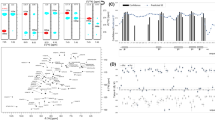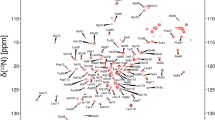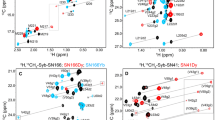Abstract
Postsynaptic density protein-95 (PSD95) contributes to the postsynaptic architecture of neuronal synapses and plays an important role in controlling synaptic plasticity. The N-terminal domain of PSD95 (residues 1–71, called PSD95-NT) interacts with target proteins (calmodulin, α-actinin-1 and CDKL5), which regulate the Ca2+-dependent degradation of glutamate receptors. We report complete backbone NMR chemical shift assignments of PSD95-NT (BMRB No. 50752).
Similar content being viewed by others
Avoid common mistakes on your manuscript.
Biological context
PSD95 is a membrane-associated protein composed of three PDZ domains, followed by a src homology 3 (SH3) domain and a C-terminal guanylate kinase region. The N-terminal region of PSD95 (residues 1–71) interacts with a number of target proteins, such as calmodulin (Zhang et al. 2014), α-actinin-1 (Matt et al. 2018), and CDKL5 (Zhu et al. 2013). PSD95-NT also contains palmitoylation sites that are important for Ca2+-dependent membrane targeting (Greaves et al. 2011). The PDZ domains in the N-terminal portion of PSD95 interact with specific (Ser/Thr)-Xxx-Val motifs at the C termini of the target proteins. Such interactions mediate PSD95 binding to the central GluN2 subunits of NMDA-type glutamate receptors and to the auxiliary stargazin and related TARP subunits of AMPA-type glutamate receptors (Lim et al. 2002; Xu 2011). Thus, PSD95 mediates postsynaptic targeting of these receptors (Elias et al. 2008; Schnell et al. 2002). PSD95 plays a central role in Ca2+-mediated regulation of postsynaptic glutamate receptor localization that occurs during long-term potentiation (LTP), which depends on Ca2+ influx through the NMDA receptor (Tomita et al. 2005; Sumioka et al. 2010). Furthermore, PSD95 is palmitoylated at N-terminal residues (Cys3 and Cys5), which is important for its postsynaptic localization and for postsynaptic targeting of AMPA receptors (El-Husseini et al. 2002). Intriguingly, Ca2+ influx also causes PSD95 relocalization (Sturgill et al. 2009; Zhang et al. 2014; Chowdhury et al. 2018).
Although structures are known for various PDZ domains and PSD95-NT bound to calmodulin (Zhang et al. 2014), atomic level structural information is currently not known for the full-length PSD95. We report here NMR resonance assignments of the N-terminal region of PSD95, which precedes the first PDZ domain and targets PSD95 (and bound glutamate receptors) to postsynaptic sites upon its palmitoylation of Cys3 and Cys5. These NMR assignments may be useful for the future screening and possible discovery of target proteins that bind to the PSD95 N-terminal domain.
Methods and experiments
Expression and purification of PSD95-NT. A GST-tagged PSD95 N-terminal construct (residues, 1–71) (pGEX-4T3 vector) was transformed into Escherichia coli strain BL21(DE3) for protein overexpression and purification by following a standard protocol (Zhang et al. 2012). The 15 N/13C-labeled PSD95-NT was expressed in one liter of M9 medium supplemented with 0.5 g of 15 N-labeled NH4Cl and 2.5 g of 13C-labeled glucose. The purified GST-fusion protein was digested by thrombin to remove the N-terminal GST tag, producing an N-terminal fragment of PSD95 (residues 1–71, called PSD95-NT) that was further purified by gel-filtration size-exclusion chromatography (Superdex 75).
NMR spectroscopy. Protein samples of 15 N- or 13C/15 N-labeled PSD95-NT were exchanged into NMR buffer containing 25 mM CD3COONa (pH 5.0) with 1 mM EDTA-d12, 1 mM DTT-d10 and 95% H2O/5% D2O. The isotopically labeled PSD95-NT was concentrated to give a final concentration of 0.4 mM in a final volume of 0.3 mL. All NMR experiments were performed at 285 K on a Bruker Avance III 800 MHz spectrometer equipped with a four-channel interface and triple resonance cryogenic (TCI) probe. The 15 N-1H HSQC spectrum (Fig. 1) was recorded with 256 × 2048 complex points for 15 N(F1) and 1H(F2). Assignment of backbone resonances was obtained by analyzing the following spectra: HNCACB, CBCA(CO)NH, HNCO and HBHA(CO)NH. The NMR data were processed using NMRPipe (Delaglio et al. 1995) and analyzed using Sparky (Lee et al. 2015).
Assignments and data deposition
Figure 1 presents the 15 N-1H HSQC spectrum of PSD95-NT to illustrate representative backbone resonance assignments. NMR assignments were based on 3D heteronuclear NMR experiments performed on 13C/15 N-labeled PSD95-NT. The resonances (1HN, 15 N, 13Cα, 13Cβ, 1Hα, 1Hβ, and 13CO) were detected and assigned for all 71 residues. A non-native serine residue was detected at the N-terminus due to a cloning artifact and is designated as S0. Surprisingly, the N-terminal serine residue exhibits an amide resonance in the HSQC spectrum, which suggests that the N-terminal amine group must be modified somehow as an amide, perhaps caused by N-acetyl modification or another N-acyl linkage at the N-terminus. The residue numbering begins with the methionine at the second position, designated as M1 (Figs. 1, 2). The amide proton chemical shifts exhibited very narrow chemical shift dispersion (within 8.0–8.7 ppm), suggesting a solvent exposed random coil conformation for the entire 71-residue peptide chain, which is consistent with a lack of any ring-current shifted amide or methyl resonances. The backbone chemical shift assignments (1H, 15 N, 13C) for PSD95-NT have been deposited in the BioMagResBank (http://www.bmrb.wisc.edu) under accession number 50752.
Primary and secondary structure of PSD95-NT. The secondary structure of each residue (random coil conformation depicted as C) was calculated on the basis of chemical shift index (CSI) as defined by (Wishart et al. 1992). The chemical shift difference (ΔCα and ΔCβ) for each residue was calculated as the observed chemical (for Cα and Cβ) minus the random coil chemical shift (Wishart et al. 1995) and is plotted as a function of residue number in the lower panel
The previous NMR structure of calmodulin bound to PSD95-NT revealed a helical structure for the first 17 residues of PSD95 (Zhang et al. 2014). Thus, the binding of calmodulin sequesters the N-terminal residues, Cys3 and Cys5 and prevents their palmitoylation needed for membrane targeting. The secondary structure of PSD95-NT in the absence of calmodulin (calculated by chemical shift index (Wishart et al. 1992)) indicates a random coil conformation for the entire 71-residue peptide (Fig. 2) that we suggest may increase the exposure and availability of Cys3 and Cys5 for palmitoylation by palmitoyl transferase enzymes. The chemical shift differences (ΔCα and ΔCβ in Fig. 2) suggest a slight propensity for an α-helix in the first 10 residues from the N-terminus; however, the magnitude of the chemical shift differences here are quite small and less than 2-fold greater than the experimental error. The helical structure of the N-terminal residues of PSD95 (residues 1–17) bound to calmodulin must be stabilized by the binding of calmodulin, because the PSD95 N-terminal helix converts into a random coil in the absence of calmodulin. A similar structural change in PSD95-NT is likely to occur upon binding to other target proteins such as α-actinin-1 (Matt et al. 2018) and CDKL5 (Zhu et al. 2013; Zhang et al. 2014). The NMR chemical shifts reported here will be useful in the future for screening conformational changes in the N-terminal domain of PSD95 upon binding to the various protein targets.
Data availability
The assignments have been deposited to the BMRB under the accession code: 50,752.
References
Chowdhury D, Turner M, Patriarchi T, Hergarden AC, Anderson D, Zhang Y, Sun J, Chen CY, Ames JB, Hell JW (2018) Ca(2+)/calmodulin binding to PSD-95 mediates homeostatic synaptic scaling down. EMBO J 37:122–138
Delaglio F, Grzesiek S, Vuister GW, Zhu G, Pfeiffer J, Bax A (1995) NMRPipe: a multidimensional spectral processing system based on UNIX pipes. J Biomol NMR 6:277–293
El-Husseini A, Schnell E, Dakoji S, Sweeney N, Zhou Q, Prange O, Gauthier C, Aquilera A, Nicoll RA, Bredt DS (2002) Synaptic strength regulated by palmitate cycling on PSD-95. Cell 108:849–863
Elias GM, Elias LA, Apostolides PF, Kriegstein AR, Nicoll RA (2008) Differential trafficking of AMPA and NMDA receptors by SAP102 and PSD-95 underlies synapse development. Proc Natl AcadSci U S A 105:20953–20958
Greaves J, Carmichael JA, Chamberlain LH (2011) The palmitoyl transferase DHHC2 targets a dynamic membrane cycling pathway: regulation by a C-terminal domain. MolBiol Cell 22:1887–1895
Lee W, Tonelli M, Markley JL (2015) NMRFAM-SPARKY: enhanced software for biomolecular NMR spectroscopy. Bioinformatics 31:1325–1327
Lim IA, Hall DD, Hell JW (2002) Selectivity and promiscuity of the first and second PDZ domains of PSD-95 and synapse-associated protein 102. J BiolChem 277:21697–21711
Matt L, Kim K, Hergarden AC, Patriarchi T, Malik ZA, Park DK, Chowdhury D, Buonarati OR, Henderson PB, GokcekSarac C, Zhang Y, Mohapatra D, Horne MC, Ames JB, Hell JW (2018) alpha-Actinin Anchors PSD-95 at Postsynaptic Sites. Neuron 97(1094–1109):e9
Schnell E, Sizemore M, Karimzadegan S, Chen L, Bredt DS, Nicoll RA (2002) Direct interactions between PSD-95 and stargazin control synaptic AMPA receptor number. Proc Natl AcadSci U S A 99:13902–13907
Sturgill JF, Steiner P, Czervionke BL, Sabatini BL (2009) Distinct domains within PSD-95 mediate synaptic incorporation, stabilization, and activity-dependent trafficking. J Neurosci 29:12845–12854
Sumioka A, Yan D, Tomita S (2010) TARP phosphorylation regulates synaptic AMPA receptors through lipid bilayers. Neuron 66:755–767
Tomita S, Stein V, Stocker TJ, Nicoll RA, Bredt DS (2005) Bidirectional synaptic plasticity regulated by phosphorylation of stargazin-like TARPs. Neuron 45:269–277
Wishart DS, Sykes BD, Richards FM (1992) The chemical shift index: a fast and simple method for the assignment of protein secondary structure through NMR spectroscopy. Biochemistry 31:1647–1651
Wishart DS, Bigam CG, Holm A, Hodges RS, Sykes BD (1995) 1H, 13C, 15N random coil NMR chemical shifts of the common amino acids. J Biomol NMR 5:67–81
Xu W (2011) PSD-95-like membrane associated guanylate kinases (PSD-MAGUKs) and synaptic plasticity. CurrOpinNeurobiol 21:306–312
Zhang Z, Li Z, Sacks DB, Ames JB (2012) Structural basis for Ca2+-induced activation and dimerization of estrogen receptor a by calmodulin. J BiolChem 287:9336–9344
Zhang Y, Matt L, Patriarchi T, Malik ZA, Chowdhury D, Park DK, Renieri A, Ames JB, Hell JW (2014) Capping of the N-terminus of PSD-95 by calmodulin triggers its postsynaptic release. EMBO J 33:1341–1353
Zhu Y, Li D, Wang L, Lu B, Zheng J, Zhao S, Zeng R, Xiong Z (2013) Palmitoylation-dependent CDKL5–PSD-95 interaction regulates synaptic targeting of CDKL5 and dendritic spine development. Proc Natl AcadSci U S A 110:9118–9123
Acknowledgements
We thank Jeff Walton and Ping Yu for technical support and help with NMR experiments. Work supported by NIH Grants (EY012347) to J.B.A and (RR11973) to the UC Davis NMR facility.
Author information
Authors and Affiliations
Corresponding author
Additional information
Publisher's Note
Springer Nature remains neutral with regard to jurisdictional claims in published maps and institutional affiliations.
Rights and permissions
Open Access This article is licensed under a Creative Commons Attribution 4.0 International License, which permits use, sharing, adaptation, distribution and reproduction in any medium or format, as long as you give appropriate credit to the original author(s) and the source, provide a link to the Creative Commons licence, and indicate if changes were made. The images or other third party material in this article are included in the article's Creative Commons licence, unless indicated otherwise in a credit line to the material. If material is not included in the article's Creative Commons licence and your intended use is not permitted by statutory regulation or exceeds the permitted use, you will need to obtain permission directly from the copyright holder. To view a copy of this licence, visit http://creativecommons.org/licenses/by/4.0/.
About this article
Cite this article
Zhang, Y., Hell, J.W. & Ames, J.B. Chemical shift assignments of the N-terminal domain of PSD95 (PSD95-NT). Biomol NMR Assign 15, 347–350 (2021). https://doi.org/10.1007/s12104-021-10028-5
Received:
Accepted:
Published:
Issue Date:
DOI: https://doi.org/10.1007/s12104-021-10028-5






